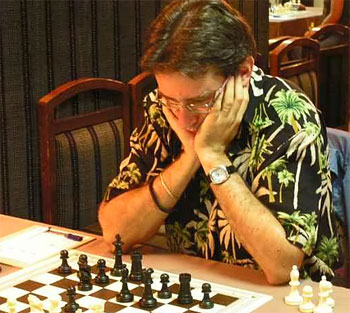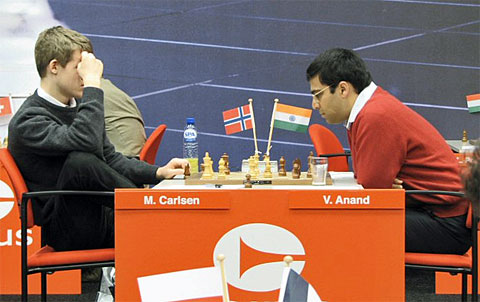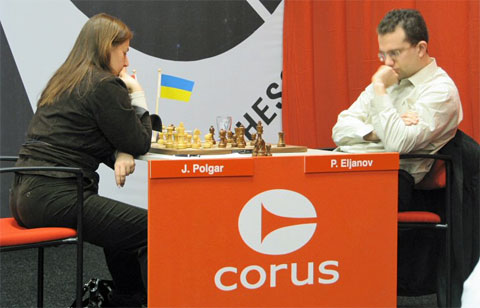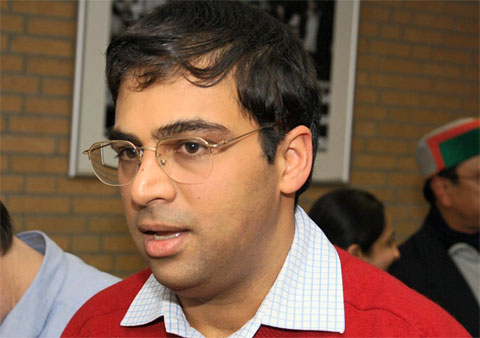Wijk aan Zee 2008

GM Mihail Marin in tournament play
The following express commentary was provided by Romanian grandmaster Mihail
Marin, who is the author of a number of very popular ChessBase
training CDs and articles for ChessBase Magazine. GM Marin will study the games
of the World Championship tournament in much greater detail and provide the
full results of his analysis in the next issue of ChessBase
Magazine.
Round eleven commentary by GM Mihail Marin
| Group A: Round 11 - Fri. Jan. 25th |
| Levon Aronian - Loek van Wely |
1-0 |
| Vassily Ivanchuk - Michael Adams |
½-½ |
| Judit Polgar - Pavel Eljanov |
0-1 |
| Veselin Topalov - Shak. Mamedyarov |
½-½ |
| Boris Gelfand - Teimour Radjabov |
0-1 |
| Peter Leko - Vladimir Kramnik |
½-½ |
| Magnus Carlsen - Vishy Anand |
0-1 |
This was the most spectacular round so far, with sharp attacks, unexpected
blunders and... four decisive games (the record for this year's edition).

Carlsen built up a very promising attacking position against Anand's Scheveningen
Sicilian. At the critical moment, he failed to find the most efficient continuation
and slightly later missed a probable draw. Anand's king escaped to the centre
and White was soon left with a material disadvantage and... with his own king
under fire.

The Boy from Baku Mark II: Teimour Radjabov, now equal 2nd-4th in Wijk
In Gelfand-Radjabov, the mutual attacks on opposite wings developed with similar
speed. Soon, both kings remained exposed to the attack of the enemy major pieces.
The game would most probably have ended in a draw, but Gelfand failed to notice
a small nuance and was mated.

Loek van Wely analysing his loss with Levon Aronian
Aronian defeated van Wely in the same line that yielded him a win against
Gelfand, with the significant difference that the Armenian grandmaster sat
on the opposite side of the board now!

Polgar-Eljanov started as a positional battle, in which Black's pair of bishops
compensated for the weaknesses on light squares. Judit played slightly carelessly
and soon got under decisive attack.

Veselin Topalov working hard in his game against Shak Mamedyarov
Despite prolonged fight, Topalov could not break Mamedyarov's defence in
what used to be one of the Ex-World Champion's favourite weapon: the King's
Indian.

Peter Leko during his game against Vladimir Kramnik...

... and being interviewed after the game

Top British (English?) GM Michael Adams in action

Ol' Blue Eyes is back: Vassily Ivanchuk with 6.0/11
Ivanchuk-Adams and Leko-Kramnik were just two "correct" draws in
28 moves.
Gelfand,B (2737) - Radjabov,T (2735) [E94]
Corus A Wijk aan Zee NED (11), 25.01.2008 [Mihail Marin]
1.d4 Nf6 2.c4 g6 3.Nc3 Bg7 4.e4 d6 5.Be2 0-0 6.Nf3 e5 7.0-0 Nbd7 8.Be3
8...Re8!? A relatively rare move. Black provokes his opponent to lock the
centre, but theory considers that the rook will remain misplaced after
9.d5
, when Black's counterplay is based on ...f5.
9...Nh5 10.g3 Bf8
A couple of years ago, a very good friend of mine mentioned this plan to me. In
the King's Indian, Black frequently suffers from lack of space for his minor pieces.
After the bishop's retreat, such a regrouping is enabled: ...Nh5-g7, ...Be7, ...f5,
...Rf8 and ...Nf6. My friend also added that White can spare several tempi (four,
if I counted well) by playing the Czech Benoni: 1.d4 Nf6 2.c4 c5 3.d5 e5 4.Nc3
d6 5.e4 Be7, later to be followed by ...Nd7, ...Ne8 or ...Nh5, ...g6, Ng7, etc.
We both included this outfashioned opening into our repertoire and obtained good
results with it (each one at his own level, of course). We also decided to call
it "The Romanian Benoni", because decades ago it served Victor Ciocâltea
and Florin Gheorghiu rather well... In any case, the "worsened" form
of the Czech Benoni will work out well in this game, too.
11.Ne1 Ng7 12.Nd3
f5 13.f3 Be7 14.Qd2 Nf6
15.c5. Well, in the Czech Benoni you do not have to fear this move really.
15...fxe4 16.fxe4 Bh3 17.cxd6 cxd6 18.Rfc1 Ng4 19.Bxg4 Bxg4 20.Nb5 Rf8 21.Rc3
a6 22.Nc7 Rc8 23.Rac1 Qd7 24.Nf2 Bd8 25.Qc2 Rf3 26.Qb3 Rxc7 27.Rxc7 Bxc7 28.Nxg4
Qxg4 29.Rxc7 Ne8 30.Re7 Qxe4 31.Rxe8+ Kf7 32.Rc8 Rxe3 33.Qxb7+ Kf6 34.Rf8+ Kg5
With both kings exposed, a draw by perpetual is not completely out of question.
35.Qxh7? Overlooking a simple detail. He should have driven the enemy
king back with 35.Qe7+ Kh6 , when after, say, 36.Qxd6 Black could have forced
a draw in several ways, for instance with 36...Re1+ 37.Rf1 Qd4+ 38.Kg2 Re2+ 39.Kh3
Qxb2 40.Qf8+ Kg5 41.Qe7+ Kh6 42.Qf8+ and so on, but nothing more than that.
35...Re1+
36.Rf1 Qd4+ 37.Kg2
37...Re2+. The difference is that after 38.Kh3 the black king becomes
a useful attacking piece, enabling mate in one with 38...Qg4#. 0-1. [Click
to replay]

Boris Gelfand and Teimour Radjabov analyse after their game
Carlsen,M (2733) - Anand,V (2799) [B85]
Corus A Wijk aan Zee NED (11), 25.01.2008 [Mihail Marin]
1.e4 c5 2.Nf3 d6 3.d4 cxd4 4.Nxd4 Nf6 5.Nc3 a6 6.Be2. It is refreshing
to see that young players believe in the virtues of classical schemes. With
the apparently modest development of the bishop to e2, White refrains from any
early attempt to "refute" Black's Sicilian, but relies on the fact
that his advantage of space and attacking chances on the kingside will leave
him with the better chances in a complicated middlegame. 6...e6 7.a4 Nc6
8.0-0 Be7 9.Be3 0-0 10.f4 Qc7 11.Kh1 Re8
This position had been submitted to thorough testing during the second match Karpov-Kasparov,
back in 1985. Having lost the match and obtained a negative score against the
Scheweningen, Karpov practically gave up... 1.e4, which immediately put the classical
system under a cone of shadow. However, Karpov's decision must have been dictated
by purely psychological reasons; White's is far from having exhausted his resources
yet, as the present game proves.
12.Bf3 Rb8 13.Qd2 Bf8
The modern trend. In similar positions, Kasparov preferred to develop his other
bishop first.
14.Qf2 Bd7. During his press conference, Anand confessed
that he did not expect 1.e4 and expressed his discontent with respect to his last
move. In any case, the position was not new for him. Against Adams, in Linares
2005, he continued with 14...e5 15.Nde2 exf4
(15...b5!? as played in the
more recent game Grischuk-Rublevsky, Candidates' matches, Elista 2007, might be
an improvement.
) 16.Bb6 Qe7 17.Nxf4 and Black did not equalize. Anand's
move aims to refrain from clarifying the situation in the centre for the time
being. It should be said that a similar approach served Kasparov quite well in
the aforementioned match. In those games, after the standard operation ...Nxd4
B(Q)xd4 ...e5, he usually maintained the tension in the centre by delaying the
capture on f4. This left him exposed to the further advance of White's f-pawn
and was proved not to be entirely sound by ulterior analysis. However, White's
position was not easy to handle from practical point of view and the final parts
of the games saw Karpov struggling each time. To a certain extent, the same scenario
will be displayed in the current game...
15.g4! Once the retreat of the
f6-knight has been blocked, this move immediately puts Black under pressure.
15...e5.
Black has to react in the centre somehow. 15...Nxd4 16.Bxd4 e5 Is less effective
here, because of 17.fxe5 dxe5 18.Bb6 (Paralyzing Black's queenside counterplay
based on ...b5) 18...Qc6 19.g5 followed by the knight jump to d5.
16.Nf5 exf4
17.Bxf4 Be6 18.Rad1 Ne5 19.Bxe5 dxe5 20.g5 Nd7
A very interesting position. White has made significant progress with his kingside
attack. All his pieces are actively placed (maybe with the exception of the
bishop, which for the time being is useful for just strengthening the control
over the d5-square). However, it can be noticed that he has also made certain
strategic concessions. The absence of the dark-squared bishop combined with
the weaknesses induced by the advance of the g-pawn will leave White's position
in ruins if his attack fails. At the same time, a successfull attack would necessarily
involve material sacrifices (or even series of sacrifices), which is always
difficult to accomplish from practical point of view. Back in the '60s, when
there were no ratings, no computers and prizes were rather low, players would
have been delighted to get the chance of starting a sacrificial attack, but
in the modern era one is frequently exposed to such involuntary thoughts as:
"Would Fritz agree with my sacrifice?" or "How much rating would
I drop if he defends?" Fortunately for the spectators, the ulterior course
of the game will prove that Carlsen was not influenced by such inhibitions in
any way. 21.Nd5 Qc6. Anand said that he rejected the immediate 21...Qc5
because of 22.Qg2 . Indeed, this move seems to consolidate White's advantage
of space. The standard operaion ...Bxf5 exf5 ...e4 just loses a pawn, while
White can strengthen his pressure starting with, say, Rd3. 22.Bg2. Clearing
the f-file for the major pieces. White had no time to secure his queenside with
22.a5 because of 22...Bxf5 23.exf5 e4 with counterplay in the centre. 22...Qc5.
Now that the g2-square has been occupied by another piece, this move makes
more sense. In case of 22...Qxa4?! 23.Nc7 , the pressure against the f7-square
would become unpleasant. 23.Qh4!?
This is the start of incalculable complications. White abandons his queenside
pawns for the sake of a massive attack. The immediate threat is Rd3-h3.
23...Qxc2.
This is not really greediness. By eliminating this pawn, Black prevents both
Rd3 and Rf3.
24.Rc1 Qxa4. This move, too, has a concrete purpose. By placing
the e4-pawn under a pin, Black hopes to releave his position by a well-timed exchange
on d5 or f5 followed by the queen exchange. In case of 24...Qxb2 25.Rc3! Bxd5
26.Rh3 h6 27.gxh6 g6 28.exd5 there is no immediate obvious win for White, but
his strong concentration of forces against the weakened black kingside is quite
annoying.
25.b3!? Carlsen is ready to give up his last remaining queenside
pawn for the sake of misplacing the enemy queen. The immediate 25.Rc3 g6 26.Rh3
h5 27.gxh6 could have been met by 27...Bxf5
(During his press conference,
Anand mentioned the line
27...Bxd5 28.h7+ Kh8 29.exd5 Qxh4 30.Nxh4 "when
the f7-pawn is not easy to defend". He continued his line with
30...g5
31.Rxf7 gxh4 32.Rxd7 Re7 33.Rxe7 Bxe7 when after
34.Rc3 Black's position
remains unpleasant.
) 28.h7+ Kh8 and Black seems to be able to defend.
25...Qa5?!
From here, the queen can be switched to the defence of the kingside with
either ...Qd2 or ...Qd8. However, these resources do not seem to be sufficient
for succesful defence in case of White's best continuations. Anand must have thought
that 25...Qxb3!? would have meant going too far, but this seems to have offered
better chances to repell the attack. Here is a possible continuation: 26.Rc3 Bxd5!
(26...Qa4? would lose after
27.Rh3 h6 28.gxh6 g6 29.Nf6+! Nxf6 30.h7+)
27.Rxb3 Bxb3 28.Rf3 Rbc8 29.Rh3 h6 After the elimination of the d5-knight,
White's attacking potential has been reduced dramatically. Besides, his back rank
has remained weak. On the top of everything, Black has some material advantage
and his position remains strategically better.
26.Rc3 g6 27.Rh3 h5
We have reached the culminating moment of the game. Practically all White's pieces
are involved in the attack in a way or another, but it is not easy to find the
most harmonious way to combine their action.
28.Bf3?! The manoeuvre initiated
with this move is too time consuming and will allow Black regroup properly. The
obvious 28.gxh6 was not entirely clear, either, for instance 28...Qd8! 29.Qg3
Rc8 30.Nh4 Kh7 (Consolidating the g6-square) 31.Nf3 Be7 32.Nxe7 Qxe7 33.Ng5+ Kh8
and Black seems to be OK in a complicated position.; I believe that the most efficient
attacking move would have been the paradoxical retreat 28.Ng3! which seems to
leave White's pieces congestioned, but in fact ads the decisive touch to White's
coordination (my special thanks to the Spanish IM Antonio Torrecillas for mentioning
this possibility). Before examining concrete lines, let us understand the abstract
merits of knight move. The knight was not doing much on f5 already and was permanently
exposed to the capture (with either the bishop or the pawn). Moreover, it blocked
the king's rook's action along the f-file. The immediate threat is Nxh5 followed
by Nf6+ with devastating threats. Let us check: 28...Bg4
(This move aims
to consolidate the h5-pawn, but leaves the f7-square insufficiently well defended.
I like the line
28...Bxh3? 29.Bxh3+- very much, because it shows that the
white bishop is quite usefull, too, as a reserve attacking piece. Black is just
lost here because of the threat Bxd7 followed by Nf6+.
; Anticipating the
threat with
28...Bg7 does not serve Black well, either after
29.Nxh5!
gxh5 30.Nf6+! Kf8 31.Nxh5 when such threats as Nxg7, g6 and Rhf3 are not easy
tod eal with at the same time.
; 28...Bxd5 also fails to eliminate the danger
because of
29.Nxh5! gxh5 30.Qxh5 Bg7 31.exd5+- when White is attacking
with his queen, 2 rooks, bishop and... two far advanced pawns. Black is just lost.
)
29.Nxh5!
Analysis diagram
It appears that thismove is possible anyway, because the g4-bishop is overcharged:
it cannot provide sufficient defence to the h5- and f7-squares at the same time!
29...gxh5 (Or 29...Bxh5 30.Qf2 f5 31.gxf6 Re6 32.Rxh5 gxh5 33.Bh3+-
followed by Rg1+ with decisive attack.) 30.Qf2 (30.Rg3!? threatening
Rxg4 is also interesting.) 30...f5 (The only way to avoid immediate
disaster. If the bishop returns with 30...Be6 , White continues his attack
with 31.Rxh5 followed by Qh4 and Nf6+.) 31.gxf6 and Black's position
cannot resist for too long. The only defenders of the kingside (the g4-bishop
and the h5-pawn) cannot ensure His Majesty's piece for too long, because of
such threats as Rg3xg4, Ne3xg4 or even the more direct Rxh5! and if ...Bxh5,
then Qf5 or Qh4 (while there is something to be done with the threat f7+, too).
28...Bxd5 29.exd5 Bg7 30.Bxh5 gxf5 31.Bxf7+ Kxf7 32.g6+ Kg8
White has managed to shake the enemy kingside from its basement, but this has
costed him quite dearly: he is two pieces down, while the d5-knight has been exchanged,
too.
33.Qh7+? After this impatiente check, Black will repell the attack
by simple means, maintaining big material advantage. White's last possibility
to stay in the game was 33.Rxf5 for instance 33...Qxd5+
(33...Qa1+ leads
to similar consequences after
34.Kg2 Qb2+ 35.Rf2 Qxf2+ 36.Qxf2 , with the
difference that the d5-pawn has not been eliminated in between.
) 34.Rhf3
Qxf3+!?
(Aiming to maintain the tension. Black could force a draw by perpetual
with
34...Qd1+ 35.Rf1 Qd5+ , because
36.Kg1? allows the exchange
of queens with
36...Qd4+) 35.Rxf3 Nf8 36.Qc4+ Ne6 Black has a material
advantage, but the exposed position of his king makes a draw by perpetual the
most probable result.
33...Kf8 34.Rxf5+ Ke7 35.Qxg7+ Kd6 36.Rf7
36...Qxd5+ Quite sadly, the white king is more exposed than his colleague
now. White's attack is over and he is simply lost. 37.Kg1 Rbd8 38.Rh7 Qd4+
39.Kg2 Qg4+ 40.Kh1 Rg8 41.Rf6+ Kc7 42.Qe7 Qe4+. A truly fantastic game,
for which both players deserve the highest praise. 0-1. [Click
to replay]

Phew, made it! Anand after his game against Magnus Carlsen

Magnus after his super-sharp game against Anand
All pictures by Jeroen van den Belt

CORUS CHESS MEET 2008 Round 11
Impressions and interviews from round eleven
Anand analyses his game against Magnus Carlsen
Links















